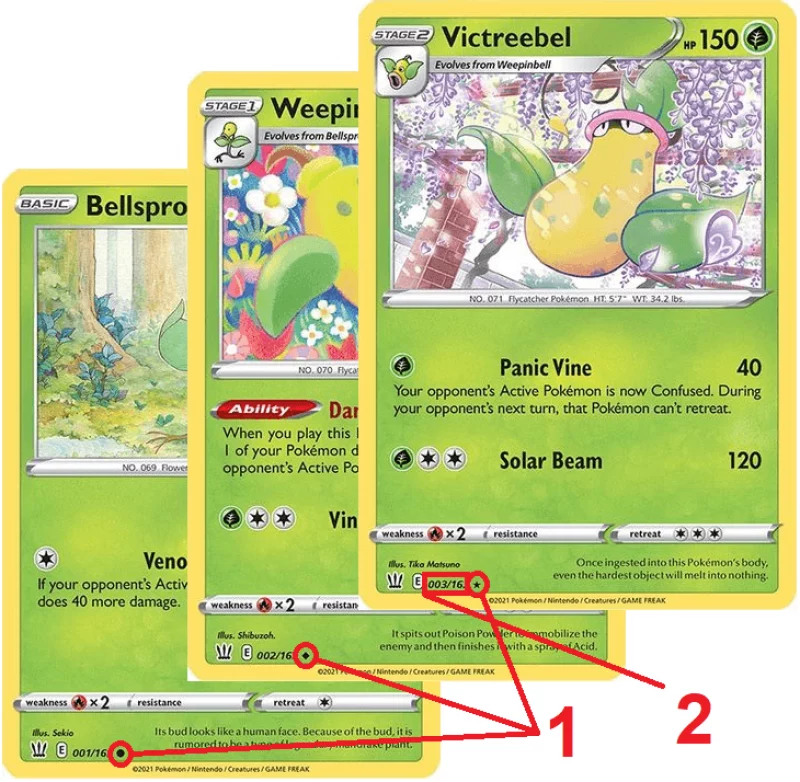A genuine regular Pokemon card is a standard-sized 2.48 inches (6.3 cm) x 3.56 inches (8.8 cm). All regular Pokemon cards are exactly the same in size.
Jumbo Pokemon Card Sizes
There are also bigger Jumbo Pokemon cards but the Jumbo sizes vary, depending on when they were made and which series they belong to.
Jumbo or oversized cards are generally used as promotional material at special events and not for gameplay. The first oversized Pokemon card was the 6 inches (15.24 cm) x 8 inches (20.32 cm) version of the base set Pikachu.
When the Pokemon Company took over the Pokemon TCG, it decided to create a bigger Jumbo card around 8 inches (20.32 cm) x 9 inches (22.86 cm) for a bigger draw.
With the Sword and Shield expansion, the oversized card was adjusted to 5.75 inches (14.605 cm) x 8 inches (20.32 cm) so it could fit the new oversized card binders the Pokemon Company had started to print.
It is important to know genuine Pokemon card sizes because they are the first step in identifying whether a Pokemon card is authentic or fake.
How To Tell If A Pokemon Card Is Fake
Other telltale signs to look out for to determine whether your Pokemon card is genuine or fake are:
- Check the size. If it’s a regular-sized card, it should measure exactly 2.48 inches (6.3 cm) x 3.56 inches (8.8 cm). A genuine Jumbo Pokemon card can be as long as 9 inches (22.86 cm). Check when it was made and which series it belongs to.
- Check the spelling carefully. Most fake cards are made in China and display poor English.
- Check the number. Every Pokemon card has a clearly visible number. In counterfeit cards, either the entire number or a part of it is not legible as it has been blurred. Also, every Pokeman card’s number is unique. Counterfeit cards usually display an identical number on completely different cards.
- Check the symbol. Every genuine Pokemon card has a little symbol alongside its unique identifying number. This symbol can either be a circle, a diamond, or a star. The shape symbol tells you how rare or common the card is. It is also indicative of its trading value.
Pokemon Card Symbols and Rarity
The symbol commonly appears at the bottom of the card, in the lower left corner, but it can appear anywhere else. You can tell the rarity of the Pokemon card according to this list:
- Black Circle – Common Rarity
- Black Diamond – Uncommon Rarity
- Black Star – Rare Rarity
- Black Star with the word “PROMO” – Promo Rarity (given out only on related special events such as a movie or game releases)

Image source: Techraptor
How To Open Pokemon Cards
Avid collectors who have their Pokemon cards graded know how important it is to keep their cards in as perfect condition as possible.
Opening your genuine Pokemon card pack right helps you protect your Pokemon cards’ value. Bending or damaging the cards in any way lessens their value.
To open your Pokemon card pack correctly, you should open the pack from the top. Loosen the card pack’s back flap to separate the packing seal and allow the cards to slide out easily.
Here are 5 detailed steps on how to do this:
- Begin by loosening the back flap of your foil pack.
- Slide your finger underneath the flap. Gently lift the flap up to loosen it from the top of the pack.
- Hold the back flap between the finger and thumb of your one hand, then use your other hand’s thumb to push the top away from where you pulled the flap.
- The seal should begin to separate at the seam with a gap showing. Continue to push until the gap is large enough for your finger to be gently inserted.
- Carefully slide your finger across the top seam, completely opening the pack. There should be a big enough hole right across the top for the cards to safely slide out without risking damage.
How To Protect Pokemon Cards
To protect your Pokemon cards from damage and maintain their value, observe these recommended guidelines:
- Always wash your hands before handling your cards. Your skin’s natural oils can damage the surface of the cards.
- Make sure not to leave your cards in a humid environment. The humidity can cause your cards’ edges to curl up. It can also make your cards damp and stick to each other.
- Organize your cards according to sets and numbers so that it would be easy to find any particular card you want. You don’t have to go through handling all the cards.
- Store them in an album, a binder, a tin can, or a hard card case with a zipper. If you’re using an album, a binder, or a hard card case, it would be a good idea to use a sleeve for each card for added protection.
The main thing to remember is that the cards should be snug and not be moving around a lot in too big a storage space. Constant moving against each other causes friction, which can damage the surface of the cards.
Pokemon cards in mint condition are the most sought-after in the card trading market. The rarest ones can fetch thousands of dollars or more.
According to the Guinness World Records, the most expensive Pokemon card ever sold is a Professional Sports Authenticator (PSA) grade 10 Pikachu Illustrator card that boxer Logan Paul purchased for $5.275 million in April 2022.
The Illustrator card, given out to 39 winners of the 1997 and 1998 Pokemon illustrations contests, is very rare. Only 23 have been PSA-certified and only 1 card has been given a PSA rating of 10 (perfect condition).
This is the one that was bought by Logan, which he wore on a chain around his neck to his April 2022 Wrestlemania 38 appearance, where he was also presented with a certificate for the world record.
FAQ
Jumbo or oversized Pokemon cards are generally used as promotional material at special events and not for gameplay.
The first oversized Pokemon card was the 6 inches (15.24 cm) x 8 inches (20.32 cm) version of the base set Pikachu.
To determine whether a Pokemon card is genuine or fake, you can check its size, spelling, number, and symbol. The size of a regular-sized card should measure exactly 2.48 inches (6.3 cm) x 3.56 inches (8.8 cm), while a genuine Jumbo Pokemon card can be as long as 9 inches (22.86 cm). Most fake cards are made in China and display poor English. Every Pokemon card has a clearly visible number, and every Pokeman card’s number is unique.
he shape symbol on a genuine Pokemon card tells you how rare or common the card is and is also indicative of its trading value. The rarity of the Pokemon card can be determined according to the symbol. Black Circle signifies common rarity, Black Diamond signifies uncommon rarity, Black Star signifies rare rarity, and Black Star with the word “PROMO” signifies promo rarity (given out only on related special events such as a movie or game releases).
- What Size is Regular Printer Paper? Quick Guide for Paper Dimensions - June 18, 2023
- What Size is My Monitor: A Comprehensive Guide - June 18, 2023
- How Big is Italy Compared to the US? A Concise Comparison - June 16, 2023

